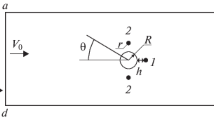Abstract
A semiempirical model of the electrohydrodynamic actuator operating on the basis of a dc corona discharge is proposed. The model is based on calculations of an electric field and a unipolar ion jet generated by a linear ion source on the surface of a dielectric plate and propagating along the plate in the laminar boundary layer. The ion source intensity and the potential difference on the actuator electrodes are determined experimentally. Estimates of the velocity induced by the electrohydrodynamic action in the flat-plate laminar boundary layer are obtained on the basis of the model. A comparison of the calculation results with the available experimental data confirms the adequacy of the model proposed. The effect of the adsorption properties of the dielectric surface on the distributions of the volume and surface electric discharge in the boundary layer is investigated within the framework of this model.
Similar content being viewed by others
References
S. El-Khabiry and G. Colver, “Drag Reduction by DC Corona Discharge along an Electrically Conducting Plate for Small Reynolds Number Flow,” Phys. Fluids 9, 587–599 (1997).
R.V. Mendes and J. Dente, “Boundary-Layer Control by Electric Fields,” J. Fluids Engng. 120, 626–629 (1998).
J.R. Roth, D.M. Sherman, and S.P. Wilkinson, “Electrodynamic Flow Control with a Glow-Discharge Surface Plasma,” AIAA J. 38, 1166–1172 (2000).
T.C. Corke, E.J. Jumper, M.L. Post, D. Orlov, and T.E. McLaughlin, “Application of Weakly-Ionized Plasmas as Wing Flow-Control Devices,” AIAA Paper, No. 350 (2002).
G. Artana, J. D'Adamo, L. Leger, E. Moreau, and T. E. Touchard, “Flow Control with Electrohydrodynamic Actuators,” AIAA J. 40, 1773–1779 (2002).
C.L. Enloe, T.E. McLaughlin, R.D. VanDyken, and J.C. Fisher, “Plasma Structure in the Aerodynamic Plasma Actuator,” AIAA Paper, No. 844 (2004).
V.A. Kas'yanov, “Investigation of EGD Flows with Application to the Problems of Boundary Layer Control and Energy Conversion,” Doctoral Dissertation in Technical Sciences (Institute of Civil Aviation Engineering, Kiev, 1970).
J. C. Mateo-Velez, F. Thivet, F. Rogier, G. Quinio, and P. Degond, “Numerical Modelling of Corona Discharges and Their Interaction with Aerodynamics,” in 1st Europ. Conf. Aerospace Sci. (EUCAS), Moscow, Russia, 2005.
A.B. Vatazhin, V.I. Grabovskii, V.A. Likhter, and V.I. Shul'gin, Electrogasdynamic Flows (Nauka, Moscow, 1983) [in Russian].
A.P. Kuryachii, “Unipolar Jet Induced by an Ion Source on a Plate,” Uch. Zap. TsAGI 22, No. 3, 128–131 (1991).
V.V. Ushakov, “Kinetics of Surface Discharge Accumulation and Boundary Conditions in Electrohydrodynamics,” in Some Problems of Aerodynamics and Electrohydrodynamics, (Institute of Civil Aviation Engineering, Kiev, 1968) [in Russian], Vol. 3, 103–113.
V.V. Ushakov, “Propagation of an Ion Jet along a Dielectric Surface for Ree≪ 1,” in: Some Problems of Aerodynamics and Electrohydrodynamics (Institute of Civil Aviation Engineering, Kiev, 1970) [in Russian], Vol. 6, 104–109.
Additional information
Original Russian Text © A.P. Kuryachii, 2007, published in Izvestiya Rossiiskoi Akademii Nauk, Mekhanika Zhidkosti i Gaza, 2007, Vol. 42, No. 3, pp. 61–70.
Rights and permissions
About this article
Cite this article
Kuryachii, A.P. Simulation of an electrohydrodynamic DC actuator. Fluid Dyn 42, 389–397 (2007). https://doi.org/10.1134/S0015462807030076
Received:
Issue Date:
DOI: https://doi.org/10.1134/S0015462807030076




